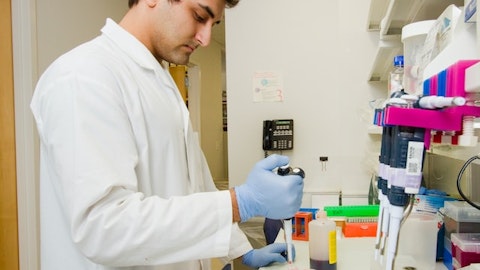Jennifer Bath: Sure, Will. This is Jennifer again. I’ll take that question for you. So, yes, so first of all, I think it’s essential to acknowledge that these are substantial investments we’ve made in Talem and for the acquisition of BioStrand. And these investments, as well as the recent fundraising are at a valuation that we don’t believe and may not currently reflect our intrinsic value. So first of all, I’d like to touch just a little bit then on the strategic rational behind these investments. Really both Talem and BioStrand bring unique and complementary capabilities to IPA. Talem has obviously been the subject of internal investments as we’ve invested in assets within TOLUM. And then BioStrand’s technologies are pivotal in enhancing our core competencies and diversifying our product offerings and expanding our market reach.
So really going back to fundamentally the mission that we have continued to articulate in the end-to-end services in discovery and development for BioStrand. The BioStrand offerings are really an integral and important part of that aspect of what we are offering as we continue to listen to our client needs. And so the strategic integration of that, we really believe creates a more robust platform for potential significant synergies. We also believe this creates long-term value creation. While the current market cap and recent fundraising reflect a momentary evaluation in a volatile market, the investments in both Talem and BioStrand are projected to yield returns in the future. And that includes expanding into new markets, accelerating product development, and leveraging cross-selling opportunities across our end-to-end spectrum of services.
And I think that’s something that we really should not overlook as that ability for us to go ahead and tie really directly into the existing clients that IPA have which are extremely loyal and already utilizing our services at IPA which really make a great market entry for us. Then just lastly with the acquisition of BioStrand and then combining that with Talem’s capabilities, we do think that there are numerous different market segments and customer segments that we are able to tap into. So it’s not just about increasing revenue streams, but also building more resilient and also diversified business models for IPA.
Will McHale: Got it, thanks. So it sounds like you’re saying the raise last week, while not at an ideal valuation was necessary because we have to make these investments now to meet the market opportunity. Is that the gist of it?
Jennifer Bath: Yes, Specifically on the raise, that’s exactly right. Well, there are several opportunities that we feel are really important to capitalize on here in the short term that we really do believe provide substantial revenue returns for IPA. And in particular, the two that we really highlighted with respect to this decision that wasn’t taken lightly with regard to the issuance of the common shares is the expansion of our facilities, in particular in Victoria, where again, similar to what happened in Utrecht, we are at client capacity, and we have client demand for increased number of services, increased number of programs for our clients in both B-cell and also actually in protein production there in Victoria and then the other one was isn’t with BioStrand.
That market is moving really quickly, BioStrand is moving really quickly and we feel it’s imperative to make an investment in BioStrand for this push for the LENSai portal and the SaaS model due to the high projected return in benefits to IPA.
Will McHale: Got it. Thanks. One more quick question. As you look at BioStrand and kind of the product roadmap there, how closely are you evaluating whether it’s new features or functionalities in conjunction with existing CRO clients?
Jennifer Bath: Can you repeat the question one more time, Will?
Will McHale: Sure. The question is, as you look at BioStrand’s product roadmap and kind of the different features and modules you’re building, are those a result of direct requests from clients? Or how do you determine exactly where the next feature or module is going to be built?
Jennifer Bath: Yes, that’s a fantastic question. So first of all, as I mentioned earlier in the script, we’re always in very close communication with our clients, with the project leads at these industries. With many of them, we have several decades of relationships with them. And they’re very open and clear about what their needs are, what their pain points are. I mean, going back to even the mission that we put forward with IPA with regard to the end-to-end discovery and development services, that’s exactly why we did that, because we were answering to these pain points that our clients had, and that’s exactly what we’re doing with BioStrand. Before the acquisition of BioStrand, there were a number of areas where we were just absolutely certain that a really good AI platform could help us to address some of these needs that our clients had.
And obviously after the acquisition, it really became clear as our clients continued to articulate this, that there were several things that they were seeking. Part of it is the speed with which we’re able to do some of the work that’s currently done in wet lab environments, and some of the work that we currently were not offering in the wet lab environment. With artificial intelligence, we’re obviously able to tackle some of those requirements much more rapidly for our clients, which is one of their major pain points and one of their major demands. But in addition to that, we’ve seen this real shift in the industry too, where we’ve tackled a lot of the easier targets for many different diseases. And those diseases in our clients are coming with more complicated targets that oftentimes just don’t lend themselves very well to wet labs or require a combination of a lot of in silico tools along with wet lab.





